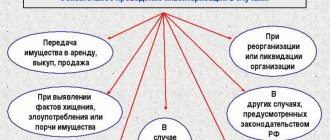Starting from 2021, control over the calculation and payment of insurance premiums is largely carried out by the Federal Tax Service. The Social Insurance Fund also has the right to administer part of the payments calculated from employee salaries. In what cases can contributions be additionally accrued and how to reflect the amounts based on the inspection report in accounting?
Question: What actions should the tax authority take to re-qualify the GPC agreement into an employment contract for the purposes of additional assessment of insurance premiums? View answer
Who checks?
So, the legislator gives the tax service and the Social Insurance Fund the right to carry out inspections. Inspections can be both desk-based and on-site.
Refusal to accept payment amounts for credit is not a reason for additional assessment of insurance premiums
Insurance premiums are verified:
- for compulsory pension insurance - Federal Tax Service;
- for compulsory health insurance - Federal Tax Service;
- in case of temporary disability and in connection with maternity (“sick leave”) - the Federal Tax Service;
- insurance against accidents at work and occupational diseases (contributions for injuries) - Social Insurance Fund.
On a note! The recipient and administrator of the contributions may not be the same. For example, the recipient of contributions under compulsory pension insurance is the Pension Fund, in case of temporary disability - the Social Insurance Fund. The Federal Tax Service monitors the completeness and urgency of payment of contributions.
IMPORTANT! A complaint to a higher authority against the tax authority’s decision to charge additional insurance premiums from ConsultantPlus is available at the link
Most often, scheduled inspections are carried out according to a schedule that complies with federal legislation. However, if a company undergoes reorganization, is liquidated, or a supervisory authority receives a complaint from an employee, an unscheduled inspection is carried out.
For periods up to 2021, inspections are carried out by the FSS and the Pension Fund.
How to appeal additional tax assessment in court?
The right to appeal an additional tax assessment based on the results of an audit in court arises if other pre-trial methods of settlement have been exhausted.
The resolution on additional tax assessment is a non-normative act and is contested in accordance with Chapter 24 of the Arbitration Procedure Code of the Russian Federation.
In order to appeal a tax authority decision that is non-regulatory in nature, you need to contact the arbitration court at the location of the tax authority with a statement of claim. The claim must contain demands for invalidation of the non-normative legal act.
The APC presents requirements for a claim to appeal an additional tax assessment:
- Name of plaintiff, defendant
- Details of the contested act
- Indication of the violated rights with reference to the relevant norms
In addition, you must attach:
- evidence of sending the claim to the defendant
- copy of registration certificate
- act being appealed
- documents that are the basis of the plaintiff’s arguments
- document confirming payment of state duty - 3000 rubles
The limitation period is 3 months.
The case is considered according to the rules of claim proceedings - in court hearings with the parties summoned. The consideration of the case by the court takes place within no more than 3 months, and if the case is complex – up to 6 months.
If the court refuses to satisfy the claims, an appeal and cassation appeal of the judicial act is possible.
USEFUL : order an appeal against the court decision with the help of our Ekaterinburg lawyer
Reasons for additional contributions
Additional assessment of contributions, as a rule, is a consequence of underestimating the base in calculations.
In practice, errors most often occur for the following reasons:
- Incorrect application of settlement rates. Thus, the current rate for compulsory health insurance is 22%, for compulsory medical insurance – 5.1%, for compulsory social insurance – 2.9%, and contributions “for injuries” depend on the type of activity of the company. Their value can range from 0.2 to 8.5%.
- Incorrect use of base limits for calculating insurance premiums for the current year. A similar situation may arise if the company is large, the wages of employees are quite high and at some point may exceed the limits established by government regulation in relation to one employee. In such cases, for pension contributions the basic tariff is set at 10%, and for contributions to the Social Insurance Fund, accrual occurs only within the limit (Article 425 of the Tax Code of the Russian Federation). Errors affect the OPS and OSS databases.
- Errors in including payments in the contribution base. In a general sense, this is the employee's income subject to contributions. The list of income is given in Art. 420 of the Tax Code of the Russian Federation, and in Art. 422 contains a similar list of amounts not included in the base. For example, financial assistance only in the amount of up to 4,000 rubles is not subject to contributions; compensation for unused vacation upon dismissal may be mistakenly not included in the base, etc.
The reason for additional accrual may also be calculation errors, incorrect transfer of data from previous periods, or even deliberate evasion of payment of contributions.
Based on the act, the company is obliged to calculate an additional amount to the funds, reflect it in accounting and make payment or resolve the issue in court.
Additional taxes
Taxes assessed by inspectors during an audit are, in fact, errors discovered. They need to be corrected in accounting depending on the period to which they relate.
If these are taxes for the current year, then they must be accrued on the date of the audit decision.
If taxes relate to last year, and the annual balance has not yet been approved, then the additional accrual must be shown in December of last year.
If additional accruals relate to previous periods, the reporting for which has already been approved, then the accountant will have to figure out whether the amount is significant.
For minor errors, a rule is established: they are shown on the date of detection (in this case, on the date of the inspection decision). Minor errors should be reflected as losses from previous years identified in the reporting period in the debit of account 91 (in the case of income tax - in the debit of account 99).
How to reflect additional accrual in reporting?
Additional charges must be reflected:
- in the calculation of insurance premiums, which is submitted to the Federal Tax Service;
- in form 4-FSS, which is submitted to the Social Insurance Fund.
In both cases, adjustment reports are submitted, where the adjustment number is indicated in the appropriate field.
When paying additionally accrued contributions (respectively, “for injuries” - to the Social Insurance Fund, the rest - to the Federal Tax Service) and possible penalties for them, it is important to pay attention to the current payment details. As a rule, they are indicated in the inspection report. If an error occurs, the payment may be classified as unclear and the obligation to pay additional contributions will not be fulfilled. It is necessary to submit an application for clarification of payment.
Additional VAT calculation
The situation with additional VAT charges is quite ambiguous. The law does not provide precise instructions on where additional VAT amounts are recorded. However, there are some recommendations. In particular, additional VAT charges must be reflected in expenses only if this circumstance exists - the amount of additional charges forms the initial cost of products or services (Article 170 of the Tax Code of the Russian Federation), but it was accepted for deduction by mistake. When an inspection report is received, the amounts are reflected in the cost price if they are already involved in determining income tax (based on letter of the Ministry of Finance No. 03-07-11/222 dated June 7, 2008).
In all other circumstances, additional VAT is not included in expenses. The basis is subparagraph 19 of Article 270 of the Tax Code of the Russian Federation. It states that the tax that was charged to the buyer cannot be accepted as an expense. However, there is an alternative opinion. In particular, VAT can be included in other expenses on production and sales that reduce the base (subclause 1 of clause 1 of Article 264 of the Tax Code of the Russian Federation). In particular, some courts adhere to this position. An example is FAS Resolution No. A32-5096/2007-12/27 dated August 10, 2009.
If a person does not want to enter into conflicts with the tax authorities, then you should not include additional VAT charges in expenses. Only the permanent liability is reflected.
What wiring needs to be done?
In accounting, the correction of errors is regulated by PBU 22/2010. The current year's error is corrected in the month in which it was detected (clause 5). If the error is related to the reporting period, it is corrected by posting Dt 20, 25, 44, etc. Kt 69 (according to the corresponding contribution subaccounts).
If we are talking about the previous reporting year, the reporting for which has already been signed, then Dt 91 Kt 69 - in case of a minor error (clause 14 of the PBU). If the error is significant, and the reporting for the year has already been signed, use posting Dt 84 Kt 69 (clause 9 of PBU).
At the same time, the right to determine the significance of an error remains with the organization (clause 3 of the PBU), and therefore many, especially small firms, use the entry Dt 91 Kt 69 (in terms of subaccounts reflecting the types of contributions) for additional accrual.
The issue of reflecting fines under the act has not been fully regulated. Many experts attribute the fine to the account. 91 as other expenses, and a penalty for 99. At the same time, instructions for using the chart of accounts (Order No. 94n 10/31/2000), as well as letters from the Ministry of Finance (see No. 03-03-06/1/42 dated 29/ 01/2007) allow us to say that account 99 reflects the amounts of tax penalties due throughout the year. In this regard, it seems possible to take into account penalties and fines by posting Dt 99 Kt 69.
For example, if, according to the inspection report for the previous period, additional contributions in the amount of 300 rubles were accrued (an insignificant error), a posting is made Dt 91/2 Kt 69 - 300 rubles. Fine the organization in the amount of 200 rubles. and a penalty of 150 rubles. will be taken into account Dt 99 Kt 69 - 350 rubles. Dt 69 Kt 51 – 650 rub. an additional payment was made according to the inspection report and the sanctions were paid off.
Interesting nuance! According to tax authorities, errors in calculations when calculating insurance premiums for compulsory medical insurance cannot serve as a refusal to accept the report. In doing so, they refer to Art. 431 of the Tax Code of the Russian Federation, paragraph 7 (Letter of the Federal Tax Service dated 02/19/18 No. GD-4-11/ [email protected] ). At the same time, when checking, on the basis of Art. 88 of the Tax Code of the Russian Federation, the tax authority will report the error, and it can be corrected with an updated calculation, which is submitted within 5 days. This rule does not apply to community pension contributions.
Briefly
- The administration of wage contributions is handled by the Federal Tax Service, with the exception of contributions for injuries, which are administered by the Social Insurance Fund. The reasons for additional assessment of contributions may be: incorrect interpretation of legislative norms, arithmetic errors, malicious negligence.
- Additional assessment of contributions based on the inspection report entails the need to:
- reflect new data in accounting;
- submit updated calculations to the Federal Tax Service and Social Insurance Fund;
- pay contributions using the correct details, along with penalties and fines.
- In accounting, additional amounts of contributions for previous years are most often reflected in Dt 91. If the error is significant, Dt 84 is taken into account. The accounts correspond with the account. 69 in terms of subaccounts reflecting contributions.
- Sanctions reflect either Dt 91 or Dt 99 accounts. This issue needs to be regulated in the accounting policies.
Grounds for additional tax assessment
The tax office assesses additional taxes based on the results of on-site and desk audits for a number of reasons. Additional assessment is the procedure for the tax inspectorate to recalculate the tax base and the amount of tax for the period in which errors or distortions were discovered.
Thus, the reason for additional taxes is distortions in the calculation of the tax base.
At the same time, enterprises calculate the tax base for the purposes of paying different taxes, and the reasons for their additional assessment may be different.
In practice, there are the most common reasons that can be regarded by the tax authority as a distortion in calculating the tax base.
The tax base is distorted when the tax authorities have established and proven the following facts:
- receiving income that was not included in the declaration;
- “inflating” expenses;
- unjustified receipt of tax benefits.
All reasons are indicated in the letter of the Federal Tax Service No. BS-4-11/20019 “On Taxation” dated November 16, 2015.
Article 54.1 of the Tax Code defines distortion of the tax base as facts of reduction of the tax base by misrepresentation of the facts of economic life by:
- Conducting a transaction for the purpose of non-payment or incomplete payment of tax
- The obligation under the transaction is fulfilled by the proper party to the contract
Tax benefit is understood as receiving tax breaks on grounds that were created “artificially” by the organization - division of business, creation of affiliated organizations, transactions with affiliated organizations. Don’t forget about the accountant’s banal mistakes when calculating the amount of tax.
Attention: watch a video on the topic of tax audits and disputes with tax authorities, ask your question in the comments to the video and get free legal advice on the YouTube channel, just don’t forget to subscribe:
Additional accrual of insurance premiums for previous periods
→ → Current as of: October 6, 2021
The issue of additional accrual of insurance premiums for past periods may arise before the policyholder if he has mistakenly underestimated the premium base. For example, when calculating the base for one of the past periods for which reports have already been submitted to the Pension Fund, you did not take into account any payment subject to contributions.
As a result, contributions based on the results of that “erroneous” period were accrued to the funds in an incomplete amount. Now the policyholder must add additional premiums from the unaccounted amount, pay them and submit the updated RSV-1 to his PFR branch (). Moreover, the procedure should be exactly this - first payment of fees, then submission of clarification.
This way you can avoid a fine (,). The policyholder can submit updated information on contributions in two ways:
- or reflect additional accruals on line 120 of section 1 and in section 4 of the calculation for the current period. Let us note that the Fund’s specialists advocate precisely this option if incorrect information was discovered after the 1st day of the 3rd calendar month following the “erroneous” reporting period (). Let's look at this option in more detail.
- or submit exactly the updated RSV-1 for the “erroneous” period and in full. It should reflect not only corrective, but also initial data that did not require adjustment and was initially reliable. In this case, on the title page of the calculation it is necessary to indicate the adjustment number (for example, “001”);
In section 4 RSV-1 adjustment
What corrections need to be made based on the results of the audit conducted by auditors of the Social Insurance Fund or Pension Fund of Russia
October 12, 2011 October 12, 2011 Leading expert, chief accountant with 10 years of experience In the summer, we prepared material on the corrections that an accountant must make at the end of a tax audit (article “”). And this article is addressed to those who are awaiting or have already “survived” the audit of extra-budgetary funds.
In particular, we will talk about what reports need to be submitted and what entries to make after the controllers make a decision.
At the moment, the transition period continues: until 2010, companies and entrepreneurs paid a single social tax, starting from 2010 - insurance contributions to extra-budgetary funds. At the same time, both tax authorities and funds have the right to check the three calendar years preceding the current one (clause 4 of article 89 of the Tax Code of the Russian Federation and part 9 of article 35 of the Federal Law of July 24, 2009 No. 212-FZ).
This means that the audit scheduled in 2011 covers the period from 2008 to 2010. This period includes both the Unified Social Tax and contributions.
The situation is similar with the inspections that will be scheduled in 2012. Who has the right to conduct audits: employees of the Federal Tax Service or inspectors from funds? The period of time starting from 2010 is entirely under the control of the funds.
After all, the calculation of contributions, their payment, and the expenditure of funds for social insurance can be checked by inspectors from the Social Insurance Fund and the Pension Fund of the Russian Federation. They have the right to count penalties and fines for violations of contributions. The period up to and including 2009 is conditionally divided between tax officials and fund auditors.
What and how to correct in accounting based on the results of a tax audit
Fines and penalties (regardless of the tax and the period for which they are accrued) must be reflected in the debit of account 99 “Profits and losses” and the credit of account 68. The posting date will coincide with the date of the inspection decision.
In tax accounting, such amounts cannot be accepted as expenses - this is directly stated in subparagraph 2 of Article 270 of the Tax Code of the Russian Federation. Accordingly, there is no difference between tax and accounting accounting.
Example 1 In July 2011, inspectors made an inspection decision, in accordance with which they fined the company under Article 122 of the Tax Code of the Russian Federation for failure to pay VAT in 2009. The fine amounted to 5,000 rubles. In addition, the auditors assessed penalties in the amount of 1,250 rubles.
Based on the results of the audit, the accountant made the following entries in July 2011:
DEBIT 99 “penalties and sanctions” CREDIT 68 – 5,000 rub. — a fine was assessed for non-payment of VAT; DEBIT 99 “penalties and sanctions” CREDIT 68 – 1,250 rub. - penalties have been accrued.
Value added tax
The Tax Code does not provide a clear answer to the question of whether the amount of VAT accrued based on the results of an audit can be included in expenses when taxing profits.
Source: https://www.Buhonline.ru/pub/beginner/2011/7/4955







